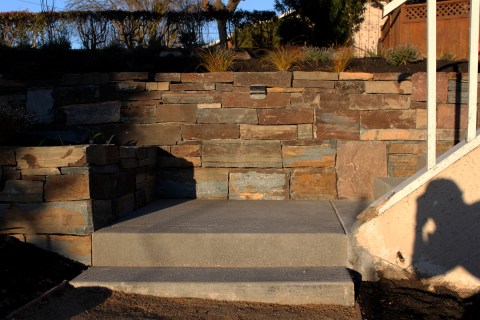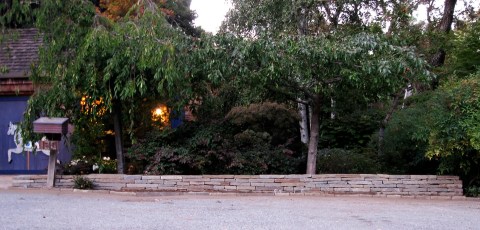Archive for the ‘walls’ Category
Teardrop Park
The day after seeing Four Freedoms Park, I walked along the Hudson River from Battery Park up to the High Line. There are a number of interesting bits of stonework along that stretch of Manhattan including the fort walls at Castle Clinton, the anachronistic Irish Hunger Memorial, and the carefully detailed 911 memorial. I also walked the High Line but its famous plantings were cut back and leafless. It’s a nice site, though, and I enjoyed it even if it wasn’t at it’s horticultural peak. But my favorite spot along the river front was Teardrop Park, a small park with a stone wall about eighteen feet high. Technically the wall is veneer, but it’s built with oversized blocks that make it much cooler than any typical veneer.
To my surprise, the posted park rules didn’t say anything about prohibiting climbing, so I went up it a few times. It would be too easy with climbing shoes, but in street shoes it was pretty fun.
The park won an ASLA award a few years ago. The project description called the stone ‘Alcove Blue Stone’; in the Bay Area, the stone’s trade name is Cabernet.
The diagonal courses of stone are meant to recall geological striations.
Other areas of the park use the striated stone as well.
I would have loved this park as a kid, and I heard several different kids cry when they were told it was time to leave.
A big slide with rocks to climb to reach the top, you can’t get much better than that. A great little park.
Wall Lighting
A little before we left for Belize I finished a project in Walnut Creek that I’d been working on for a while. No garden is ever truly finished and there are still a few things to do in this one — redoing the handrailing, painting the wall — but I’m not the one responsible for that phase so I get to call it done. Much of this project was done during the period of heavy winter rains in December and then there was a long delay while the light fixture for the wall was decided on and then fabricated. Landscape lighting generally gives more immediate gratification than any other aspect of landscaping, but we had a hard time finding the right fixture for this one. There are tons of lantern-style lights designed for eight-foot-high stuccoed walls, but not many for a three foot retaining wall of stone.
Some photos of lighting (which for some reason has attracted the biggest flurry of spam that I’ve seen in a long time) are below. (more…)
Elk Mtn. Tumbled Edging with Flowers
Thursday while I was down on the peninsula, I passed near a house where I did a small stone project last fall, so I stopped by to check out the planting that the client did afterwards. Pretty nice, and fun to see someone else’s plant choices. There wasn’t a drawing or anything when I did the project, just a request for an 8″ high wall to give a back drop to a low planting of color, and I didn’t know exactly what would go in afterwards. You can’t see so much of the stonework at the moment, but it will reappear as the plants finish their bloom cycles.
The yard had nice trees and shrubs before, but it’s a lot more interesting now. This photo from when I finished the project was in my 2010 wrap-up post.
Japanese Dry Stone Walling
Rather more on-topic is this video. The footage is from the Stone Foundation’s January workshop and symposium. 14th and 15th generation Japanese stone masons came to California to demonstrate their traditional method of dry stone castle and wall building, and to supervise the construction of some ramparts at a park in Ventura. Most noteworthy in the technique is that the walls are battered with a subtle arch/concave shape for structural stability and that each of the structures has a ‘mirror stone,’ an especially large stone meant to reflect the strength of the builder or owner. The caption says the video is a documentary in progress, but I like it as is; it’s not fast-paced, but that’s appropriate for a stonework video, and there’s some good footage of rock shaping.
The Stone Foundation has an article about the project with info and photos. The Ventura County Reporter did a writeup with a slideshow, and the Ventura County Star put video footage in theirs. I’ve never been to any of the symposiums, but I know a few people who have, and they speak really highly of them. Looks like it was pretty cool.
Connecticut Blue Tumbled
One of the other forms Connecticut Blue takes in the Bay Area is as tumbled stone for edging and very low walls. It comes in a few different widths, but the stone in this garden is 6 inches in width, which is a bit undersized for retaining walls; the stones just don’t have the mass to lock in securely. Also, the tumbling makes the stone kind of low on friction. But, that said, the stone has been in this garden a long time (since before I first saw it five years ago), and it’s really easy to re-stack any sections that shift. It’s probably one of the best stones to use if you don’t have much experience at stacking; you just try to keep the stones level and break your joints. I like it for this type of cottage garden with the plants growing around the stone, hiding it in the summer and revealing it in the winter.
In the last photo, you can sort of see from the wide joints that the stones on this section are slowly migrating down the slope. A rule of dry-stacking is to keep the stones perpendicular to gravity even on a cross-slope, like steps rather than a ramp. The more regular and rectangular the stone, the more important it is, but people don’t seem to follow that rule as much nowadays in this age of mortared stonework. It’s not a big deal with low edging that is so easy to re-stack, but it would be a problem in a larger wall. In this case, though I was spending a few hours re-stacking someone else’s stonework, I considered it more like garden maintenance than a stone repair job, and if I hadn’t been replanting the garden, the owners would have left the stone how it was. A few plant photos are below. (more…)
The Cracked Pot Moss Rock Wall
I was recently back at a garden where I did a day of rock work last summer, a short section of moss rock wall along a sloping path. When I built the wall, the client and I incorporated a couple of cracked pots into the wall where it tapers into the slope, and then she transplanted a number of her succulents to plant along the wall and in the pots. It’s one of our only gardens in which the client is also a gardener, and it was nice to now see how her planting has begun to fill in. The plants in the cracked pots still need a little more time to spread, but I think they already look pretty cool.
The wall in the background was already there, built by the company who installed the garden five years ago. I like the choice of aloes to plant along the top of it; they do well there, and their pokiness discourages people from messing with the rocks.
The garden is quite spectacular and worthy of a longer post some day. There are always things blooming and I usually take a few photos while I’m there; the shots of the swallowtail and prostanthera in my last post are from this garden. When the prostanthera is done, this member of the aster family will be in full bloom. I’m not sure what it is, but I like the look of the flower buds, and when it gets going, it puts on quite a show. Does anyone know it? I would try to figure it out, but the aster family is mighty big.
You are currently browsing the archives for the walls category.





























